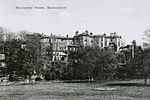Kimmerghame House
1851 establishments in ScotlandBerwickshireCategory B listed buildings in the Scottish BordersClan SwintonCountry houses in the Scottish Borders ... and 4 more
Houses completed in 1851Inventory of Gardens and Designed LandscapesListed houses in ScotlandUse British English from July 2014

Kimmerghame House is a 19th-century mansion in the Scottish Borders, located 4 kilometres (2.5 mi) south-east of Duns by the Blackadder Water. It is the seat of the Swintons of Kimmerghame, a branch of the Lowland Clan Swinton. The house was designed in the Scottish Baronial style by David Bryce in 1851. Kimmerghame is protected as a category B listed building and the grounds are included on the Inventory of Gardens and Designed Landscapes in Scotland.
Excerpt from the Wikipedia article Kimmerghame House (License: CC BY-SA 3.0, Authors, Images).Kimmerghame House
Geographical coordinates (GPS) Address Nearby Places Show on map
Geographical coordinates (GPS)
| Latitude | Longitude |
|---|---|
| N 55.756388888889 ° | E -2.2947222222222 ° |
Address
TD11 3LU
Scotland, United Kingdom
Open on Google Maps






